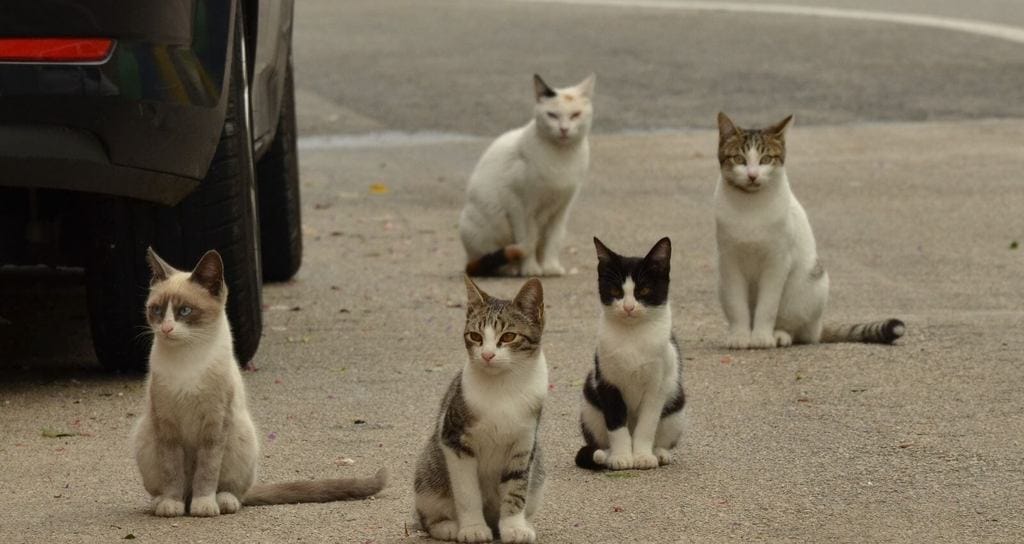Notable Characteristics of the Domestic Cat
Scientific name of the common cat: Felis silvestris
The weight of wild cats varies from 2.7 to 4 kg on average for females to 4 to 5 kg on average for males , although the weight of each cat varies greatly during the year. Domestic cats are similar in size, but can become much heavier due to overfeeding. Body length is usually between 50 and 75 cm and tail length varies between 21 and 35 cm.

Wild cats are generally gray-brown in color , with a bushy tail and a well-defined pattern of black stripes all over their body. Its fur is short and soft. Their coloring is similar to that of a tabby domestic cat and makes them difficult to see in their forest habitats.
Domestic cats have been selected by humans to exhibit a wide range of shapes and colors, from hairless forms to long-haired Persians and from tailless Manx cats to very large Maine coon cats. Colors range from black to white, with mixtures of reds, yellows and browns.

Wild cats have five toes on each of their front legs, but only four toes on each back leg. Cats have claws that can be tucked into sheaths when not in use, allowing them to stay sharp. Cat teeth are highly specialized for eating meat.

The canines are excellent for stabbing and restraining prey, as the upper ones point almost straight down and the lower ones are curved. Molars are specialized for cutting. Since wild cats don't have teeth to crush, they eat their food by cutting it into slices.

If you've ever been licked by a domestic cat, you may have noticed that their tongue is rough. This is because the tongue is covered in tiny curved protrusions. They are called taste buds. These taste buds are used for grooming and licking meat from bones.

Although cats have whiskers, they do not have eyelashes. They have a complete inner eyelid that protects the eye from damage and drying out. This inner eyelid is called the nictitating membrane.
Origins and geographical distribution of the domestic cat

Domestic cats are thought to be descended from African wild cats and are found virtually everywhere in the world in association with humans. Feral cats are found throughout continental Europe, southwest Asia, and the savannah regions of Africa.
What type of habitat do they need?
Wildcats from Africa, Asia, and Europe typically live in forested and scrubby landscapes, but they can be found in a wide variety of habitats. They are absent from extremely dry regions, such as deserts and steppes, as well as tropical rainforests and areas where winter snow depth is greater than 20 cm for more than 100 days.

They are found in areas where humans live , but usually in rural areas where the main form of agriculture is livestock grazing. Domestic cats are found in many types of habitats due to their association with humans. They thrive in regions where winters are not very cold.
How do they reproduce?

Wild cat
When a female wildcat enters estrus, local males gather near the female and compete for access to her. Males scream, yelp, show off and fight. Several males can be the fathers of different kittens from the same litter.
Breeding in wild cats takes place at different times of the year , depending on the local climate. European wildcats give birth to one litter per year. Sometimes, it can give birth to a second litter if the first was lost at the start of the season. Births generally take place in May and the number of babies per litter is between 1 and 8.

All kittens are born with their eyes closed and are unable to walk. They are breastfed and cared for by their mother for 6 to 12 weeks . They then stay with their mother, learning hunting and survival skills for 4 to 10 months. After 10 months, feral cats are kicked out of their mother's territory and must become independent.
Domestic cat

Domestic cats can breed much more frequently, up to 3 times a year. They can do this because they are not limited by nutrition or climate like wild cats are. The average litter size for domestic cats is 4 to 6.
The gestation period (pregnancy) lasts on average 65 days. Domestic kittens are weaned at around 8 weeks of age and become independent at around 6 months of age. Females are ready to mate at 6 months of age.
How long does a cat live?

European wildcats live up to 15 years in the wild , although most die before the end of their first year. Domestic cats living in a house (not free range) also live 15 to 20 years. A few domestic cats have been recorded as living up to 30 years.
Cat behavior
Feral cats and domestic cats are generally active at night or at dusk and dawn. They can be active during the day, especially in areas little disturbed by humans. Wild cats often move around a lot at night in search of prey. A European wildcat was recorded traveling 10km in a single night!
You may have heard someone say that cats are distant. This is not surprising, because feral cats mostly live alone (they are solitary). Domestic cats are more social and can be found in small family groups.

Domestic cats that live “in the wild” are also generally solitary. They can form small colonies in areas where food sources are clustered, such as landfills. In these types of cat groups, females generally stay in their birth zone while males leave their birth zone and attempt to establish a home range elsewhere.
In areas where there are concentrations of free-ranging domestic cats, a sort of hierarchy is formed. Newcomers must go through a series of battles before their position is established.
Size of a cat's territory

Male wildcats have a home range that overlaps with that of several females. A male African wildcat has been recorded with a home range of 4.3 square kilometers.
The home range of domestic cats varies greatly depending on the concentration of resources and the density of domestic cats relative to feral cats. ( IUCN Cat Specialist Group, 1996a)

How do cats communicate with each other?
Cats have scent glands on their forehead , around their mouth and near the base of their tail. A cat rubs these glands against objects to mark them with its scent. Male wild cats mark their territory by spraying strong urine on objects in their home range.

Cats communicate using visual cues , such as raising their back hairs, wagging their tails, and facial expressions. They also have a variety of sounds that communicate different intentions. These may include aggressive hissing and meowing, affectionate purring, or a squeak used to keep kittens quiet.
Cats have a very developed sense of smell and hearing. A cat's ears can rotate quickly to identify the source of a particular sound. They are capable of responding to frequencies of up to 25,000 vibrations per second.
With this ability, cats can hear even ultrasonic noises made by small rodents. This sometimes allows them to locate and capture prey without seeing it.

Their eyesight is good, but probably not better than that of humans. The range of colors perceived by cats is smaller than that of humans. Cats' eyes are located at the front of the head. This allows them to have excellent depth perception and is a useful tool for hunting.
However, this also means that cats cannot see directly under their noses. They have the ability to see the tiniest movements , which helps them locate their prey. Their eyes are adapted to vision in low light. This allows them to hunt just after dusk or before dawn.

Cats also perceive many things thanks to their whiskers ( vibrissae ) . Whiskers are special hairs that serve as highly sensitive tactile organs. A cat uses its whiskers to determine if its body can fit through small openings. They also use their whiskers to detect the movement of their prey.
What do cats eat?

The diet of wild or domestic cats consists mainly of small rodents, such as mice and rats. Other common prey are moles, shrews, rabbits and birds. However, these cats prey on almost all small animals, such as lizards, snakes and large insects.

They are capable of overpowering prey that are almost as large as themselves. They tend to stay away from prey that has thorns, shells, or foul odors. Occasionally, cats will eat grass to rid their stomachs of indigestible foods , such as bones, fur and feathers.
Do cats have natural predators?
Most wild cats are preyed upon when young by larger predators, such as foxes, wolves, other cats, and large birds of prey, such as owls and hawks.
Wild cats are ferocious when threatened and can protect themselves from animals larger than themselves. They are also discreet and agile.

Most famous cat predators:
- the red fox (Vulpes vulpes)
- gray wolves (Canis lupus)
- the domestic cat (Felis silvestris)
- owls (Strigiformes)
- hawks (Accipitridae)
What impact do cats have on the environment?
In urban and agricultural areas around the world, domestic cats are bred to help control rodent populations. European wildcats play an important role in controlling populations of rodents and other small mammals. It is this characteristic that probably led to their domestication.

Domestic cats carry a number of diseases that can be transmitted to humans , including rabies, cat scratch fever, and several parasitic infections.
Domestic cats are also responsible for population declines and extinctions of many species of birds and mammals, particularly those that live on islands.
Efforts to control populations of domestic cats that have been introduced to the islands are costing the governments involved thousands of dollars and costing us all valuable parts of the world's biodiversity. Feral cats generally have little or no negative impact on humans.
How do cats interact with humans?
Domestic cats are highly valued as pets and working animals around the world. They help control rodent populations and have been used as animal subjects in behavioral and physiological research.
Wild cats are important members of natural ecosystems. They help control populations of small mammals throughout their range.

Are cats an endangered species?
Domestic cats are not threatened . In fact, population control mechanisms are necessary in most areas as they proliferate so quickly.
As for them, African and Asian wildcats remain quite common throughout their range. However, as habitat destruction continues, they risk running out of suitable habitat.
European wildcats are critically endangered in their native range. They were largely exterminated from western and central Europe during the 19th and 20th centuries because they were considered a danger to game and domestic animals. They remain threatened by habitat loss , but populations are recovering in many parts of their former range.

Other threats to the European wildcat include population isolation, deaths from automobile collisions, and vulnerability to diseases transmitted by domestic cats. They are currently protected throughout Europe and several reintroduction efforts are underway.
The main threat to all wild cat populations, and particularly to European wild cats, is continued hybridization (crossbreeding) with domestic forms.
Hybridization leads to a reduction in the genetic purity of wild forms. Some researchers believe that genetically pure European wildcats are already extinct due to extensive hybridization.
